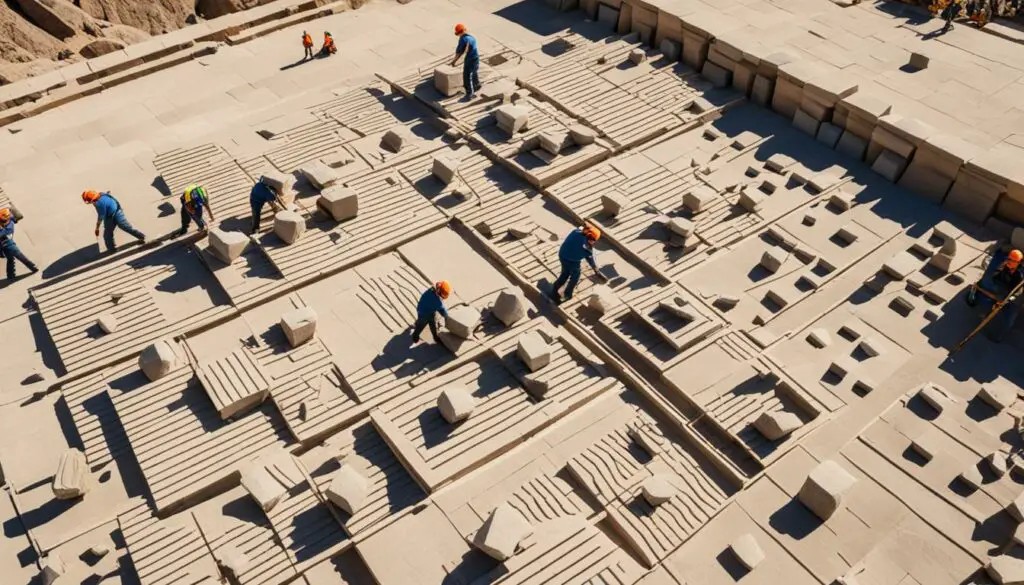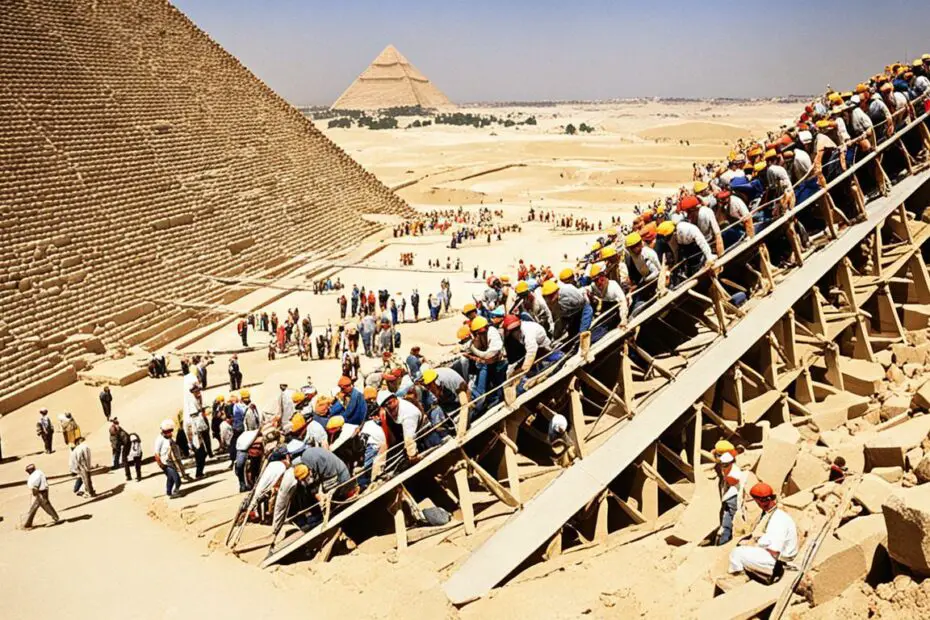Have you ever wondered how the ancient Egyptians managed to construct the magnificent pyramids that still stand today? It’s a mystery that has fascinated scholars and explorers for centuries. From the massive Great Pyramid at Giza to the intricate details of the smaller pyramids, the construction methods employed by the ancient Egyptians were truly remarkable.
But how did they do it? What were their secrets? And what can we learn from their ancient engineering techniques? In this article, we will explore the fascinating world of pyramid construction and unearth the hidden knowledge behind these ancient marvels.
Throughout history, various theories have attempted to decipher the methods used by the ancient Egyptians. Some suggest that the pyramids were built by slaves, while others propose the use of advanced technologies that surpass our understanding. However, recent discoveries have shed new light on the true construction techniques employed by this advanced civilization.
Join us on this journey as we delve into the secrets of pyramid construction and uncover the incredible ingenuity of the ancient Egyptians. Prepare to be amazed by their precision, resourcefulness, and the enduring legacy they left behind.
The Quarrying and Extraction Process
The pyramids were constructed using limestone blocks quarried from the building site. The workers used the natural geology of the quarry to extract the blocks, taking advantage of the natural thickness of the limestone layers. Channels were dug down the side of the stone, and large pry bars were used to create cracks that would eventually fracture the blocks. In some cases, structures like the Great Sphinx were actually dug from the ground and sculpted in place. This construction method allowed ancient engineers to use the natural limestone layers for block thickness. The extraction process was labor-intensive, but with a large workforce and careful planning, the stones needed for the pyramids could be quarried efficiently.

| Pyramid Building Process | Pyramid Construction Techniques | Pyramid Building History |
|---|---|---|
| Quarrying limestone blocks | Creating cracks in the blocks using pry bars | Utilizing natural limestone layers for block thickness |
| Channels dug down the side of the stone | Sculpting structures in place, like the Great Sphinx | Efficient extraction with a large workforce |
| Labor-intensive process | Careful planning for efficient quarrying |
Moving and Placing the Stones
One of the most intriguing aspects of pyramid construction techniques is the method used to move and place the enormous stones. The ancient Egyptians developed ingenious solutions to transport these heavy blocks and position them precisely in the pyramid structure.
Damp Sand and Sleds
To overcome the challenge of moving the massive stones, the Egyptians utilized a simple but effective technique. They pulled sleds carrying the stones over damp sand, reducing friction and making it easier to transport the heavy blocks. This method allowed the workforce to move the stones more efficiently, even with their immense weight.

Ramps and Dolerite Ball Bearings
Once the stones were quarried, they had to be elevated and put into their designated positions within the pyramid. The ancient Egyptians accomplished this by constructing ramps made of mud bricks or limestone. These ramps facilitated the movement of the stones to the desired height.
To enhance the movement on these ramps, the Egyptians used dolerite ball bearings. These round stones reduced friction, allowing the workers to maneuver the blocks more easily. The precision of the stone placement on the outer layers of the pyramids was meticulously executed to achieve the iconic triangular shape.
Craftsmanship and Sculpting
Skilled craftsmen played a crucial role in the pyramid construction process. After the stones were moved to the foundation and positioned, these craftsmen meticulously sculpted and shaped them. They ensured that each stone fit perfectly in its intended location, maintaining the structural integrity and aesthetic appeal of the pyramids. The high level of craftsmanship is evident in the precise alignment of the outer stones, showcasing the Egyptians’ attention to detail and architectural finesse.
Although the precision was prioritized for the exterior stones, the interior blocks received less attention to detail. Their placement was more functional rather than ornamental, as they provided the necessary support for the pyramid’s structure.
Pyramid Construction Techniques
| Technique | Description |
|---|---|
| Sleds and Damp Sand | Moving heavy stones over damp sand using sleds to reduce friction and make transportation more manageable |
| Ramps | Constructing ramps made of mud bricks or limestone to elevate the stones for placement within the pyramid |
| Dolerite Ball Bearings | Using dolerite ball bearings to minimize friction and facilitate the movement of stones on the ramps |
| Craftsmanship and Sculpting | Meticulously sculpting and shaping each stone to ensure a perfect fit and precise alignment in the pyramid structure |
Workforce and Construction Techniques
Recent research has shed new light on the workforce and construction techniques involved in the building of the pyramids. Contrary to the previous belief that the pyramids were constructed by slaves, evidence discovered by Egyptologists suggests that the builders and engineers were actually part of a large and highly skilled workforce.
Egyptologists have discovered elaborate cities near the pyramid sites, indicating that these cities housed the workers involved in the construction process. These findings challenge the assumption that the pyramids were solely the result of forced labor.
Instead, it is now believed that the builders were skilled workers who received a salary or used the construction as a form of tax payment. This new understanding attests to the high level of respect and regard that the ancient Egyptians had for their builders.
A Testament to Engineering Marvels
The precision and complexity of the pyramids serve as a testament to the engineering skills of the ancient Egyptians. Building a structure as monumental and enduring as the pyramids required a deep understanding of architecture, mathematics, and construction techniques.
Despite the limited tools and technology available at the time, the builders displayed remarkable ingenuity and resourcefulness in bringing their vision to life. The pyramids stand as enduring symbols of their mastery over construction and engineering.
The construction of the pyramids is a remarkable feat as they were built within a span of approximately 20 years. This impressive timeline emphasizes not only the efficiency of the builders but also their ability to plan, coordinate, and execute such a massive project.
The construction techniques employed by the ancient Egyptians involved careful planning, precise measurement, and ingenious methods of moving and placing the stones. These techniques demonstrate the ancient Egyptians’ remarkable understanding of structural stability and architectural design.
Overall, the workforce and construction techniques behind the pyramids highlight the genius of the ancient Egyptians and their ability to create enduring engineering marvels that continue to captivate and inspire awe to this day.
Controversial Theories and Historical Accounts
Throughout history, there have been various controversial theories surrounding the construction techniques of the pyramids. Some theories propose that the pyramids were built using a unique form of limestone concrete, while others suggest that the massive stones were cast in place using a mixture of lime and natron. Although these alternative theories exist, they are not widely accepted by the academic mainstream.
The traditional belief is that the pyramids were constructed using meticulously carved stones and mortar. This method, seen as the most plausible explanation, aligns with historical accounts from prominent ancient historians like Herodotus and Diodorus Siculus. Their writings describe the use of wooden logs as levers and the construction of ramps to move the heavy stones into place.
While the exact details of the construction techniques may never be fully known, the pyramids stand as a testament to the incredible engineering achievements of the ancient Egyptians. These enigmatic structures continue to captivate researchers, archaeologists, and visitors from around the world, inspiring awe and curiosity about the secrets of pyramid construction.
FAQ
Q: How were the pyramids built?
A: The pyramids were built using limestone blocks quarried from the building site. The workers used the natural geology of the quarry to extract the blocks, taking advantage of the natural thickness of the limestone layers. Channels were dug down the side of the stone, and large pry bars were used to create cracks that would eventually fracture the blocks. In some cases, structures like the Great Sphinx were actually dug from the ground and sculpted in place.
Q: How were the stones moved?
A: The stones used to build the pyramids were moved using sleds pulled over damp sand, which reduced friction and made it easier to transport the heavy blocks. Once the stones were quarried, they were moved onto the foundation using ramps and dolerite ball bearings.
Q: Who built the pyramids?
A: Recent research contradicts the previous belief that the pyramids were built by slaves. Instead, the builders were highly skilled workers who received a salary or used the construction as a form of tax payment. Egyptologists have discovered evidence of large elaborate cities near the pyramid sites, indicating that the builders and engineers were part of a large workforce.
Q: What are some controversial theories about pyramid construction?
A: Some theories suggest that the pyramids were built using a form of limestone concrete, while others propose that the stones were cast in place using a mixture of lime and natron. These theories are not widely accepted among the academic mainstream, and the traditional belief is that the pyramids were constructed using carved stones and mortar.
Q: What historical accounts describe the pyramid construction methods?
A: Historical accounts by Herodotus and Diodorus Siculus describe the construction methods, including the use of wooden logs as levers and ramps for moving the stones. The exact details of the construction techniques may never be fully known, but the pyramids remain a testament to the incredible engineering achievements of the ancient Egyptians.

Historians are wrong about our ancient past! Imagine a person who’s expert on Kelly’s blue book but doesn’t know how to build and operate a vehicle.